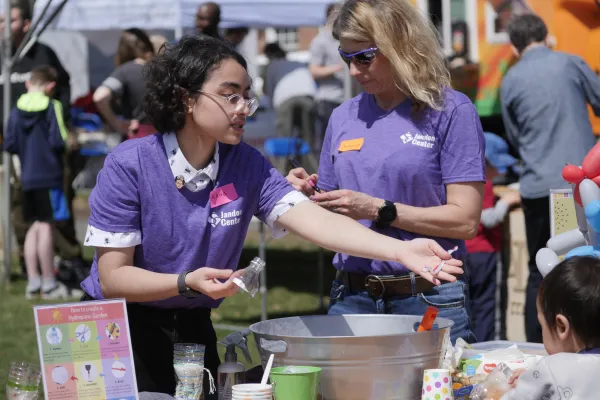Unleashing Creativity: Smith’s First Maker Faire
Research & Inquiry

Published April 23, 2019
“Making is a form of agency,” said Emily Norton, co-director of Smith’s Design Thinking Initiative, as she toured the spread of tents and tables arrayed on campus for Smith's inaugural Maker Faire.
The sun was shining, the weather was unseasonably warm, and Davis lawn was awash in color and activity for Smith’s first Maker Faire.
Hosted April 13 by the Design Thinking Initiative in partnership with the Imaging Center, Smith College Museum of Art and Mount Holyoke College, the inaugural Pioneer Valley Mini-Maker Faire drew upwards of 500 visitors for hands-on making booths, interactive outdoor installations and immersive workshops on topics ranging from drone flying to creating a fine-art superhero.
Since the first Maker Faire debuted in California in 2006, the self-described gatherings of “makers who want to show examples of their work and interact with others” have quickly grown into a worldwide phenomenon.
“Making is a form of agency,” said Emily Norton, co-director of Smith’s Design Thinking Initiative, as she toured the spread of tents and tables on campus. In addition to displaying their wares, all of the makers “have a demonstrative element to show off their creative process,” Norton said.
Engineering major Asmita Gautam ’20, for example, was a member of a team that designed an all-age “innovation playground.” She and her teammates—all University Innovation Fellows with the Design Thinking Initiative and Smith’s Jill Ker Conway Center for Innovation and Entrenpreurship—wanted to create a project highlighting the importance of play.
“Here you can explore and do whatever you want,” said Gautam, gesturing at the team’s playground filled with tools, games and gauzy butterflies with pool-noodle centers. “The goal is to have fun.”
The goal of unleashed creativity was evident in other projects displayed by some 50 makers, including a new no-flame, wood-burning technique exhibited by the We Are Makers collaborative; a homemade air conditioner created by Noah Mann, 15, of Northampton; and intricate cosplay costume designs by Ellie Wolfe ’19.
The projects also highlighted a diversity of makers.
A workshop co-sponsored by Smith’s Mwangi Cultural Center on styling headwraps, for example, wasn’t just about the mechanics of knotting, twisting and tying, but also about sharing experiences related to being a maker of color.
Makers also displayed projects aimed at solving real problems: Visitors to the fair were invited to try on radar glasses for the blind and review a live feed of a beehive monitor that tracked noise levels, temperature and humidity.
Whether it was test-driving bikes from the 1860s, creating hydroponic gardens made from water bottles or sitting on the lawn and blowing bubbles, participants were inspired to celebrate the potential for creativity contained in every mind.
Smith’s Maker Faire was co-hosted by Mount Holyoke College’s Fimbel Maker and Innovation Lab and We Are Makers. The event was made possible with support from National Grid, Maker Magazine, Cofab Design, STEAMporio, Brick Coworkshop, A2Z, Shelburne Falls Coffee Roasters and Valley Venture Mentors.
Rana Gahwagy '22 (left) and Deborah Day, STEM outreach coordinator for the Jandon Center for Community Engagement, at a booth at the Maker Faire.